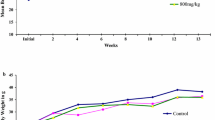Abstract
Cyanobacteria are commonly found in drinking water supplies, and are responsible by numerous cases of humans’ intoxications. Geitlerinema is a genus described as unable to form blooms, however, it is very frequent in Sao Paulo’s reservoirs, the most densely populated area in Brazil. During the search for bioactive substances from strains maintained in the Cyanobacteria Culture Collection of the Institute of Botany, Sao Paulo, Brazil, three strains of Geitlerinema spp. (CCIBt920, CCIBt1044—G. amphibium; CCIBt939—G. splendidum) showed toxicity in mouse bioassay (i.p.). The symptoms observed in this bioassay were very distinct from those presented by animals poisoned with the already known cyanotoxins. In such cases, histological analysis of vital organs is very important to determine the cause of deaths and intoxication. Histological analyses were performed in mice administrated with CCIBt920 and CCIBt1044 methanol extract (ME), and CCIBt939 0.1 M acetic acid extract (AE). All extracts caused very similar histopathological features: hemorrhagic focuses, edema, alveolar collapse and hyperplasia in the lungs, due to an increase in the number of immune system cells (macrophages); disorganization of the hepatic parenchyma, necrosis, loss of vein endothelium, presence of polymorphonuclear cells in the liver; alterations in the convoluted tubules and necrotic areas in the kidneys of mice intoxicated with CCIBt939 AE, while the other G. amphibium extracts had no major effects in this organ. The histopathological findings indicate the occurrence of inflammatory processes in the mice treated with these cyanobacteria extracts. Taken together, our results suggest the presence of new cyanotoxins(s), different from the known cyanotoxins. The isolation and characterization of this toxin(s) are in progress in our laboratories.




Similar content being viewed by others
References
Azevedo MTP, Sant’Anna CL (2003) Sphaerocavum brasiliense, a new planktic genus and species of Cyanobacteria from reservoirs of Sao Paulo State, Brazil. Algol Stu 109:79–92
Backer LCW, Carmichael WW et al (2008) Recreational exposure to low concentrations of microcystins during an algal bloom in a small lake. Mar Drugs 6(2):389–406
Bartram J, Carmichael WW, Chorus I, Jones G, Skulberg OM (1999) Chapter 1: Introduction. In: Chorus I, Bartram J (eds) Toxic cyanobacteria in water: a guide to their public health consequences, monitoring and management. E & FN Spon, London
Carvalho LR, Sant’Anna CL, Gemelgo MCP, Azevedo MTP (2007) Cyanobacterial occurrence and detection of microcystin by planar chromatography in surface water of Billings and Guarapiranga Reservoirs, SP, Brazil. Rev Bras Bot 30:141–148
Carvalho LR, Pipole F, Werner VR, Laughinghouse HD, Camargo ACM, Rangel M, Konno K, Sant’Anna CL (2008) A toxic cyanobacterial mixed bloom in an urban coastal lake, Rio Grande do Sul State, Southern Brazil. Braz J Microbiol 39:761–769
Chorus I, Bartram J (eds) (1999) Toxic Cyanobacteria in water: a guide to their public health consequences, monitoring and management. E & FN Spon, London
Dogo CR, Bruni FM, Elias F, Rangel M, Pantoja PA, Sant’Anna CL, Lima C, Lopes-Ferreira M, Carvalho LR (2011) Inflammatory effects of the toxic cyanobacterium Geitlerinema amphibium. Toxicon 58:464–470
Falconer IR (1993) Measurement of toxins from blue-green algae in water and foodstuffs. In: Falconer IR (ed) Algal toxins in seafood and drinking water. Academic Press, London
Fastner J, Heinzeb R, Humpage AR, Mischke U, Eaglesham GK, Chorus I (2003) Cylindrospermopsin occurrence in two German lakes and preliminary assessment of toxicity and toxin production of Cylindrospermopsis raciborskii (Cyanobacteria) isolates. Toxicon 42:313–321
Fusetani N, Kem W (2009) Marine toxins: an overview. In: Fusetani N, Kem W (eds) Marine toxins as research tools. Progress in molecular and subcellular biology (Marine Molecular Biotechnology). Springer, Berlin
Harada K, Kondo F, Lawton L (1999) Laboratory analysis of cyanotoxins. In: Chorus I, Bartram J (eds) Toxic cyanobacteria in water: a guide to their public health consequences, monitoring and management. E & FN Spon, New York
Hawkins PR, Runnegar MTC, Jackson ARB, Falconer IR (1985) Severe hepatotoxicity caused by the tropical Cyanobacterium (Blue-Green Alga) Cylindrospermopsis raciborskii (Woloszynska) Seenaya and Subba Raju isolated from a domestic water supply reservoir. Appl Environ Microbiol 50:1292–1295
Jancula D, Maršalek B (2011) Critical review of actually available chemical compounds for prevention and management of cyanobacterial blooms. Chemosphere 85:1415–1422
Komárek J (2003) Two Camptylonemopsis species (cyanoprokaryotes) from “Mata Atlantica” in coastal Brazil. Preslia 75:223–232
Kuiper-Goodman T, Falconer I, Fitzgerald J (1999) Human health aspects. In: Chorus I, Bartram J (eds) Toxic cyanobacteria in water: a guide to their public health consequences, monitoring and management. E & FN Spon, New York
Lawton LA, Beattie KA, Hawser SP, Campbell DL, Codd GA (1994) Evaluation of assay methods for the determination of cyanobacterial hepatotoxicity. In: Codd GA, Jefferies TM, Keevil CW, Potter E (eds) Detection methods for cyanobacterial toxins, Special Publication No 149. The Royal Society of Chemistry, Cambridge
MacKintosh C, Beattie KA, Klumpp S, Cohen P, Codd GA (1990) Cyanobacterial microcystin-LR is a potent and specific inhibitor of protein phosphatases 1 and 2A from both mammals and higher plants. FEBS Lett 264(2):187–192
Pyo D, Shin H (2002) Extraction and analysis of microcystins RR and LR in cyanobacteria using a cyano cartridge. J Biochem Biophys Methods 51:103–109
Rapala J, Sivonen K, Lyra C, Niemelä SI (1997) Variation of microcystins, cyanobacterial hepatotoxins, in Anabaena spp. as a function of growth stimuli. Appl Environ Microbiol 63:2206–2212
Runnegar M, Berndt N, Kong SM, Lee EYC, Zhang LF (1995) In vivo and in vitro binding of microcystin to protein phosphatase 1 and 2A. Biochem Biophys Res Commun 216(1):162–169
Sant’Anna CL, Azevedo MTP (2000) Contribution to the knowledge of potentially toxic cyanobacteria from Brazil. Nova Hedwigia 71:359–385
Sant’Anna CL, Melcher SS, Carvalho MC, Gemelgo MP, Azevedo MTP (2007) Planktic cyanobacteria from Alto Tietê Basin, SP, Brazil. Rev Bras Bot 30:1–17
Sant’Anna CL, Azevedo MTP, Werner VR, Dogo CR, Rios FR, Carvalho LR (2008) Review of toxic species of cyanobacteria in Brazil. Algol Stu 126:251–265
Sivonen K, Jones G (1999) Cyanobacterial Toxins. In: Chorus I, Bartram J (eds) Toxic Cyanobacteria in water: a guide to their public health consequences, monitoring and management. E & FN Spon, London
Soares RM, Yuan M, Servaites JC, Delgado A, Magalhães VF, Hilborn ED, Carmichael WW, Azevedo SMFO (2006) Sublethal exposure from microcystins to renal insufficiency patients in Rio de Janeiro, Brazil. Environ Toxicol 21(2):95–103
Spencer PS, Nunn PB, Hugon J, Ludolph AC, Ross SM, Roy DN, Robertson RC (1987) Guam Amyotrophic Lateral Sclerosis–Parkinsonism–Dementia linked to a plant excitant neurotoxin. Science 237:517–522
Stewart I, Schluter PJ, Shaw GR (2006) Cyanobacterial lipopolysaccharides and human health—a review. Environ Health 5: 7 (1–23)
Tonk L, Visser PM, Christiansen G, Dittmann E, Snelder EO, Wieder C, Mur LR, Huisman J (2005) The microcystin composition of the cyanobacterium Planktothrix agaddhii changes toward a more toxic variant with increasing light intensity. Appl Environ Microbiol 71:5177–5181
Wiedner C, Visser PM, Fastner J, Metcalf JS, Codd GA, Mur LR (2003) Effects of light on the microcystin content of Microcystis strain PCC 7806. Appl Environ Microbiol 69:1475–1481
Zagatto PA, Aragão MA, Domingues DF, Buratini SV Araujo RPA (1998) Avaliação ecotoxicológica do reservatório do Guarapiranga, SP, com ênfase à problemática das algas tóxicas e algicidas (Ecotoxicological evaluation of the Guarapiranga Reservoir, SP, with emphasis on the toxic algae and algaecides’ problem). Anais do IV Congresso Latino-Americano de Ficologia (Annals of the IV Latin-American Phycology Congress), Caxambu, June 28–Aug 03
Acknowledgments
The authors wish to thank Prof. Dr. Glaucia Maria Machado-Santelli, Biomedical Sciences Institute, University of Sao Paulo, Sao Paulo, for the help with the interpretation of lungs’ histopathological results; and Camila R. Dogo for technical assistance. This work was supported by CNPq—Conselho Nacional de Desenvolvimento Científico e Tecnológico, Brazil (307457/2008-7, 474365/2010-7, 562213/2010-4), FAPESP—Fundação de Amparo à Pesquisa do Estado de São Paulo, Brazil (2008/00173-4) and INCTTox–Instituto Nacional de Ciência e Tecnologia em Toxinas, Brazil.
Author information
Authors and Affiliations
Corresponding author
Rights and permissions
About this article
Cite this article
Rangel, M., Brunetti, R.L., Garcia, A.N. et al. Acute effects of three Geitlerinema spp. (Cyanobacteria) extracts administrated in mice: symptoms and histopathological aspects. Phytochem Rev 12, 543–553 (2013). https://doi.org/10.1007/s11101-012-9240-x
Received:
Accepted:
Published:
Issue Date:
DOI: https://doi.org/10.1007/s11101-012-9240-x




